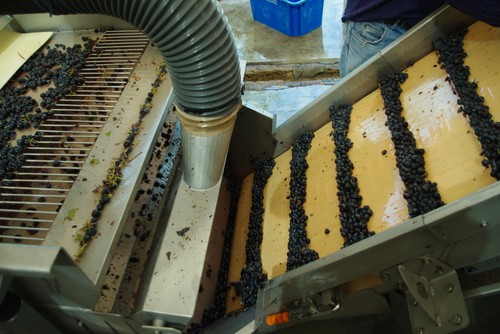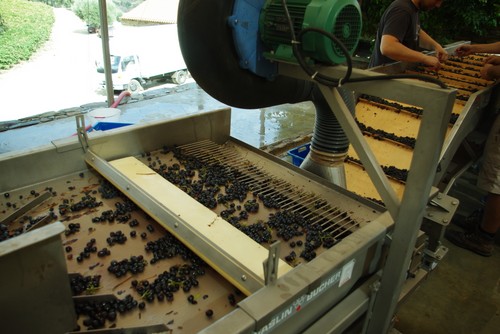The idea of selecting grapes for quality isn’t a new one. It can be done in the vineyard (choosing which grapes to pick, or going through before harvest and getting rid of the bad ones), or in the winery, or both. It’s just that now there seems to be a lot of what I term ‘hyperselection’ going on. Does this lead to better quality wines, or is it a waste of effort?
I recently wrote up a dinner with the Credit Agricole Grand Crus Bordeaux properties. They have purchased an infrared grape sorter, which is used at the two top estates (Grand Puy Ducasse and Meyney). This can sort perfectly ripe grapes from less ripe ones, even though the two are visually indistinguishable. This tool will be very useful in a vintage like 2013, where there is a high degree of variation in ripeness.

There’s also the mistral machine, which I saw in action in the Douro. Berries are destemmed and then pass over a jet of air, strong enough to blow away debris and raisined berries, but not strong enough to blow healthy, appropriately ripe berries away. This is a great idea, because raisins just add sugar and nothing else, and so eliminating them could be a way to bring the alcohol level down a little.
And this week I went to a Remirez de Ganuza lunch. This top Rioja estate does something quite unusal. Each bunch is split in two on the selection line. The shoulders go to the top wine, while the bottom of the bunch goes to the next level down, because the ripeness in this part of the bunch is a little less consistent. It’s a lot of work, but they have done the trials and think that it’s worth it.
For red wines, it’s clear that you don’t want over-ripe, ripe and unripe grapes in same vat. That doesn’t produce complex wine; it produces bad wine. Sweetness and greenness don’t work well together. And you don’t want rotten grapes in the same vat. But if you iron out any inconsistency at all, removing even the slightest greenness, is this going to produce a great wine? How much selection is too much, or is it a case of as much as possible?
5 Comments on Hyperselection: is it a good thing?



Thanks for the thought provoking read. Some very new age techniques being used in old world settings. With the importance of ‘up and coming’ estates that ‘have really lifted their game’ etc in mainstream wine media as the rest if the world looks for affordable BDX, makes good short term marketing sense. I am a marketer, but IR is going too far. They are at risk of making the reliable ‘correct’ wines that Australia has worked hard to get away from. Difference in vintage helps us learnhow the vagaries of each seasons impact on wine. commoditisation in my view.
Love the idea of the mistral machine – has potential across all styles, reduces MOG (therefore reducing a vector for spoilage) is non-chemical, potentially reduces alcohol – sounds like where wine is going to me.
As to whether you can have too much fussing over sorting – I’m often tempted to compare wine making to sake making.
With sake up to 70% of the rice grain can be milled away for some styles, which are regarded as superior by some yet at the same time the less milled styles have a very loyal and large following.
Horses for courses.
With white wines, many fine winemakers pick some grapes underripe and some grapes overripe for the different flavors they bring to a blend. This isn’t cheap to do, multiple picks. It’s intended to increase complexity.
People fear underripe red wine grapes these days because of the pyrazines, but it would be interested to see somebody try this.
Blake,
I would say people are afraid of pyrazines mainly in Bordeaux varietals for reds. I don’t see a huge pyrazine influence in Pinot Noir or Syrah.
I also think there is a rate of diminishing returns for very ripe wines in the 26+ Brix arena, for increasingly lower pyrazines.
I say, some variability grape to grape could work and seems to work for most. All within reason, damaged fruit from sunburn, rot or other acts of nature that cause excessive variability, this equipment can be helpful.
Used the Mistral for a few vineyards in 2013 due to the very high levels of rot – it pretty much seemed like a godsend in this particular case. Where the parcels were clean and showed some millerande fruit we put it to one side – otherwise the perfect tiny berries would have been blown away too 😉